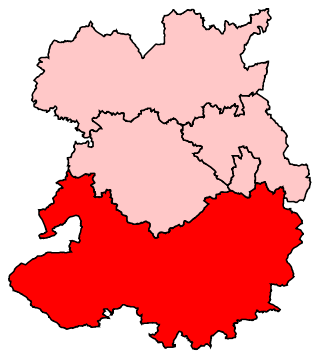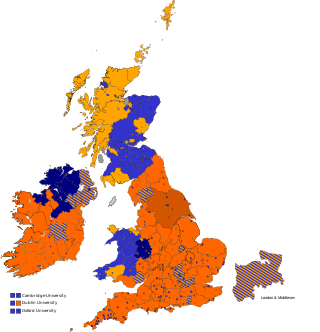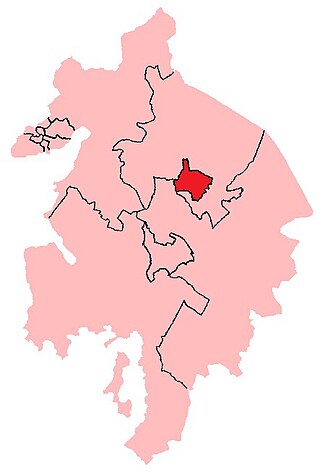
Ludlow was a constituency in Shropshire represented in the House of Commons of the UK Parliament.

Ipswich is a constituency represented in the House of Commons of the UK Parliament since July 2024 by Jack Abbott of the Labour Party.
County Antrim is a former county constituency in the House of Commons of the United Kingdom. It was a two-member constituency in Ireland from 1801 to 1885 and in Northern Ireland from 1922 to 1950.
Yarmouth was a borough constituency of the House of Commons of England then of the House of Commons of Great Britain from 1707 to 1800 and of the House of Commons of the United Kingdom from 1801 to 1832. It was represented by two members of parliament (MPs), elected by the bloc vote system.
Aberdeen Burghs was a district of burghs constituency which was represented from 1708 to 1800 in the House of Commons of the Parliament of Great Britain, and from 1801 to 1832 in the House of Commons of the Parliament of the United Kingdom.
Eye was a parliamentary constituency, represented in the House of Commons of the Parliament of the United Kingdom, encompassing an area around the market town and civil parish of Eye, Suffolk.
Thetford was a constituency of the British House of Commons. It elected two Members of Parliament (MPs) by the bloc vote system of election. It was disenfranchised under the Representation of the People (Scotland) Act 1868, which had resulted in a net increase of seven seats in Scotland, offset by the disenfranchisement of seven English Boroughs.

Shropshire was a constituency of the House of Commons of the Parliament of England, then of the Parliament of Great Britain from 1707 to 1800, and of the Parliament of the United Kingdom from 1801 to 1832. It was represented by two Knights of the Shire. It was split into North Shropshire and South Shropshire in 1832.

Shrewsbury is a parliamentary constituency in England, centred on the town of Shrewsbury in Shropshire. It has been represented in the House of Commons of the Parliament of the United Kingdom since 2024 by Julia Buckley.
Much Wenlock, often called simply Wenlock, was a constituency of the House of Commons of the Parliament of England until 1707, then of the Parliament of Great Britain from 1707 to 1800, and finally of the Parliament of the United Kingdom from 1801 to 1885, when it was abolished. It was named after the town of that name in Shropshire.
Bridgnorth was a parliamentary borough in Shropshire which was represented in the House of Commons of England from 1295 until 1707, then in the House of Commons of Great Britain until 1800, and in the House of Commons of the Parliament of the United Kingdom from 1801 until its abolition in 1885.
Wallingford was a parliamentary constituency in England, represented in the House of Commons of the Parliament of England until 1707, then of the Parliament of Great Britain from 1707 to 1800 and of the Parliament of the United Kingdom from 1801 to 1885.
Bristol was a two-member constituency, used to elect members to the House of Commons in the Parliaments of England, Great Britain (1707–1800), and the United Kingdom. The constituency existed until Bristol was divided into single member constituencies in 1885.
Sudbury was a parliamentary constituency which was represented in the House of Commons of the Parliament of the United Kingdom.
Aldeburgh in Suffolk, was a parliamentary borough represented in the House of Commons of the Parliament of the United Kingdom and its predecessor bodies.
Appleby was a parliamentary constituency in the county of Westmorland in England. It existed for two separate periods: from 1295 to 1832, and from 1885 to 1918.
Bossiney was a parliamentary constituency in Cornwall, one of a number of Cornish rotten boroughs. It returned two members of Parliament to the British House of Commons from 1552 until 1832, when it was abolished by the Great Reform Act.

Coventry was a borough constituency which was represented in the House of Commons of England and its successors, the House of Commons of Great Britain and the House of Commons of the United Kingdom.
Newcastle-upon-Tyne was a parliamentary borough in the county of Northumberland of the House of Commons of England from 1283 to 1706, then of the House of Commons of Great Britain from 1707 to 1800 and of the House of Commons of the United Kingdom from 1801 to 1918. It returned two Members of Parliament (MPs), elected by the bloc vote system.
Bletchingley was a parliamentary borough in Surrey. It returned two Members of Parliament (MPs) to the House of Commons of England from 1295 to 1707, to the House of Commons of Great Britain from 1707 to 1800, and to the House of Commons of the United Kingdom until 1832, when the constituency was abolished by the Great Reform Act.




